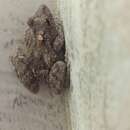Brief Summary
provided by IABIN
Diagnosis A robust, rough and glandulous medium size Scinax, with snout acuminate and very wide disks in hands and toes.
- author
- Esteban O. Lavilla
- editor
- Diego Arrieta
Distribution
provided by IABIN
In the provinces of Corrientes, Chaco, Entre Ríos, Formosa, Salta, and Santa Fé in Argentina, southern Mato Grosso and Mato Grosso do Sul in Brazil, Departaments of Alto Paraguay, Boquerón, Central, Concepción, Cordillera, Presidente Hayes in Paraguay, and Santa Cruz in Bolivia.
- author
- Esteban O. Lavilla
- editor
- Diego Arrieta
Diagnostic Description
provided by IABIN
Adult morphology About 45 mm in the largest specimens. Body oval; head flattened, as long as wide, or slightly longer. Snout ogival, pointed and protruding. Canthus rostralis not evident; loreal region grooved behind the nostril. InternariaI interval narrower than the interocular distance, wichIis wider than the upper eyelid; nostrils very close to the tip of the snout. Vomerine teeth in two nearby, heavy patches between the small choanae. Tongue wide and circular, notched and slightly free behind. Eyeslarge and prominent, their diameter being shorter than the distance from nostril to eye. Tympanum round, large and distinct, 3/4 or more of eye diameter. A very deep supratympanic fold, from the eye to the shoulder. Fingers unwebbed, fringed; disks wide in frontal side, narrowing. Toward the base, the disk of the third finger covering more than 1/2 of the tympanum. Rate of the finger lengths : I-II-IV-III. Subarticular tubercles prominent. An elongate tubercle at the base of the first finger. Toes widely webbed and fringed; subarticular tubercles strong and conical; a moderate inner and a very small, rounded, outer metatarsal tubercle. No tarsal fold present. When hindleg is adpressed, heeI reaches the eye; when the femurs are bent at right angles to body, the tibiotarsal articulations greatly overlap. Skin rough on the dorsum, scattered with minute glandular warts. Ventrally coarsely granular, as papillose. A fold across the throat, a deeper one on the chest. Vocal sac of the males, not too much evident, faintly brownish. Ground color dark gray above, with the characteristic x-shaped pattern of dorso-lateral curved stripes; inward directed. A large dark interocular spot, forming a blunt triangle, having the base between the eyes and slightly expanding over upper eyelids. Sacral spots also present; wide, oblique bars on the upper surface of he limbs, alterning with narrower lines. Posterior parts of the thighs and concealed surfaces marvles with reddish or orange-brown. Ventrally whitish or yellowish, immaculate. Larval morphology Body depressed, semiglobular, rather pisciform in lateral view, ovoid in dorsal view. Eyes intermediate-sized and lateral; in dorsal view only half of the eyes are noted. Nostril apertures dorsal. Internostral distance equal to half interorbital distance. Spiracle sinistral, terminal, fused to body wall, with elliptical opening directed posteroventrally. Vent lube is long, with a broad base narrowing to a point, located at the right side of the body. Oral disc terminal on a rectangle protruding from the snout on dorsal and ventral views; emarginate laterally, with a single row of lateral marginal papillae. Papillae are intermediate-sized, single, triangular with pointed ends and some sparse dark spots. Labial teeth dark, in well spaced rows, tooth row formula 2(2)/2-3(1); lower row equal in length to the two previous tooth rows or half the length of them. Jaw sheaths heavy and dark-pigmented. Both sheaths slightly convex, none V-shaped. Tail weakly convex, with tip pointed. Caudal muscle heavy, dorsallventral fins similar in height except on the terminal end where the dorsal fin is deeper. In formalin, body dark brown above and belly silver. Dorsal surface of body with abundant dark dots, limited by a lateral dark stripe that begins on the snout, passing backwards through the eye and crossing the body. Ventrally transparent with very little pigmentation and the coiled intestine brown. Tail fins transparent to the naked eye, in magnification dorsal fin with fewer dark dots than in dorsal surface of body. Ventral fin with dark reticulations representing tail irrigation. Caudal muscle whitish. In the living tadpole iris is golden brown, more gold at inner edge of iris and progressively more brown towards outer edge; black pigment extends from eye to nostril; dense patches of melanin on dorsolateral surface of body behind eyes, reaching slightly below eye level and not extending dorsally to tail fin; lower sides and belly silver; indefmed black line from nostril through eye joining a more pronounced large black spot above arm: dorsal and ventral surface of tail with scattered patches of melanin; tail muscle slightly but evenly flecked with melanin; knee and feet with transverse melanin bands; toes especially have bilateral melanin lines on each toe. The smallest total length specimens were stages 2 5-26 with an average of 21 mm, the largest specimen was stage 42 with total length = 36 mm. The body length varied between 7.35 and 13.8 mm with great individual variation. Maximum body width varied between 4.92 and 7.53 mm. Other than metric characteristics and the teeth variation recorded for Scinax acuminatus tadpoles, no other morphological characters vary within the sample.
- author
- Esteban O. Lavilla
- editor
- Diego Arrieta
Scinax acuminatus: Brief Summary
provided by wikipedia EN
Scinax acuminatus is a species of frog in the family Hylidae. It is found in Argentina, Bolivia, Brazil, Paraguay, and possibly Uruguay. Its natural habitats are moist savanna, subtropical or tropical moist shrubland, subtropical or tropical seasonally wet or flooded lowland grassland, freshwater lakes, intermittent freshwater lakes, freshwater marshes, intermittent freshwater marshes, pastureland, rural gardens, heavily degraded former forest, ponds, and canals and ditches. It breeds in bodies of water. It is threatened by eventual habitat loss, but the population is currently fairly stable, as it adapts fairly well to human encroachment and development.
- license
- cc-by-sa-3.0
- copyright
- Wikipedia authors and editors

